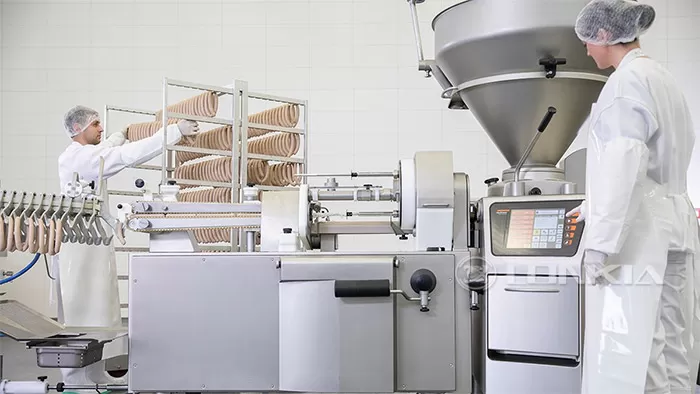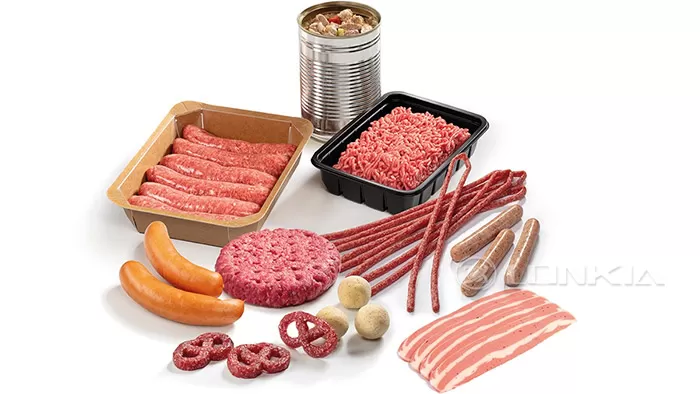The sausage production industry is evolving, with increasing demand for efficiency, consistency, and quality. Choosing between a manual and an automated sausage production line is a critical decision that impacts production speed, labor costs, product quality, and overall business profitability.
In this blog, we will compare manual and automated sausage production lines, highlighting their advantages and limitations to help you determine the best option for your business.

1. Understanding Manual Sausage Production Lines
A manual sausage production line relies heavily on human labor, with workers handling key processes such as grinding, mixing, stuffing, linking, cooking, and packaging. Although some machines may assist in specific tasks, most operations require hands-on effort.
Advantages of Manual Sausage Production
✅ Lower Initial Investment – Manual processing requires less capital, making it suitable for small or startup businesses.
✅ Flexibility for Small Batches – Ideal for specialty sausages, custom recipes, and small-scale production.
✅ Easier Recipe Adjustments – Operators can manually adjust seasoning, texture, and casing to meet specific customer preferences.
✅ Suitable for Artisanal or Handmade Products – Some premium or traditional sausages require a manual touch to maintain authenticity.
Limitations of Manual Sausage Production
❌ Lower Productivity – Manual labor slows down production, limiting output and increasing costs.
❌ Inconsistent Quality – Variations in manual processing can lead to inconsistency in size, shape, and texture.
❌ Higher Labor Costs – Skilled labor is required for sausage preparation, stuffing, and linking.
❌ Increased Risk of Contamination – More human handling raises the risk of hygiene and food safety issues.
2. Understanding Automated Sausage Production Lines
An automated sausage production line utilizes advanced machinery to handle the entire production process, from ingredient preparation to final packaging. These systems integrate automated grinders, mixers, fillers, linking machines, cooking chambers, and packaging units to maximize efficiency.
Advantages of Automated Sausage Production
✅ Higher Production Speed – Automation significantly increases output, making it ideal for large-scale production.
✅ Consistent Product Quality – Precision machinery ensures uniform sausage size, texture, and weight.
✅ Lower Labor Costs – Automation reduces the need for a large workforce, cutting down on operational expenses.
✅ Improved Hygiene & Food Safety – Minimal human handling reduces contamination risks, ensuring higher safety standards.
✅ Better Process Control & Data Tracking – Automated systems allow for real-time monitoring, ensuring consistency and compliance with industry standards.
Limitations of Automated Sausage Production
❌ Higher Initial Investment – Advanced machines require a significant upfront cost.
❌ Less Flexibility for Small Batches – Automated systems are optimized for high-volume production, making it harder to adjust for small, customized batches.
❌ Requires Skilled Technicians – Maintenance and operation of automated machinery require trained personnel.
3. Key Factors to Consider When Choosing Between Manual and Automated Production
1. Production Volume
If you produce small batches or specialty sausages, a manual production line may suffice.
If you require high-volume, continuous production, automation is the better choice.
2. Budget and Investment
Startups or small businesses with limited funds may start with manual processing.
Large-scale manufacturers can justify the higher investment in automation due to long-term cost savings.
3. Labor Costs and Availability
In areas with high labor costs or labor shortages, automation helps reduce dependency on manual labor.
If skilled workers are readily available at affordable wages, a manual system might still be viable.
4. Product Consistency and Quality Control
If you need consistent sausage size, shape, and texture, automation ensures precision.
If your brand focuses on handcrafted, artisanal sausages, manual processing offers flexibility.
5. Compliance with Food Safety Standards
Large food manufacturers often prefer automated lines for their hygiene, traceability, and safety compliance.
Manual processing requires strict hygiene protocols to meet industry standards.

4. Which One is Right for You?
| Factor | Manual Production Line | Automated Production Line |
| Production Volume | Low to medium | High |
| Initial Investment | Low | High |
| Labor Requirement | High | Low |
| Product Consistency | Variable | High precision |
| Hygiene & Food Safety | Requires strict protocols | Minimizes contamination risks |
| Flexibility for Custom Recipes | High | Limited |
| Long-Term Cost Efficiency | Higher labor costs | Lower costs over time |
5. The Future of Sausage Production: Hybrid Solutions
Some manufacturers opt for a semi-automated production line, combining manual expertise with automated machinery. For example:
- Automated grinders, mixers, and stuffers, but manual linking for custom sausage styles.
- Automated stuffing and cooking, but manual packaging for premium branding.
- Flexible modular systems that allow expansion as production needs grow.
Conclusion
Enhancing productivity in your sausage production line requires a combination of workflow optimization, automation, quality control, and effective maintenance. By investing in the right equipment, streamlining operations, and training employees, you can significantly improve output while maintaining high product standards.
At LONKIA Machinery, we provide state-of-the-art sausage production line solutions to help manufacturers achieve maximum efficiency, quality, and cost-effectiveness. Contact us today to learn how we can optimize your production process!
